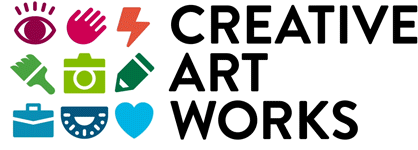Who Do You Want to Be?
“To be successful in school and in life, you need some form of reflective practice, whether that be artmaking, or writing about yourself, or personal planning. You need to have a set of tools to help you tell the story of your life.”
Freshmen in the Foundations program use art to reflect on their identities, values, and dreams.
The transition from middle school to high school can be daunting. This is particularly true at A. Philip Randolph Campus High School, which admits over 300 new students each year. That’s why the Foundations program, a required course for all incoming freshmen, was designed to help students develop a basic understanding of themselves in relation to the growth that they're experiencing as young adults in a new and often challenging environment.
The Foundations program includes artmaking projects designed by Creative Art Works to engage students in exploring their own agency and trajectory. For example, one project, called “The Game of Life,” invited students to create a board game visually representing the challenges of navigating high school, family, and friendships. It was a playful and creative way for students to feel like they have a lot of power on their life path, but also understand that there are elements of chance as well.
Foundations Students created their own “Game of Life” based on personal experiences
“The activities in Foundations were designed to be open-ended and to respect different learning styles. I think that flexibility made the program successful.”
Most students in Foundations did not identify as artists, yet all were willing to try something new.
CAW fielded three Teaching Artists to cover the various sections of this program: Abby Walsh, Natalie Raskin, and Farah Mohammad. While each TA adhered to the basic principles of the program, they also brought their own unique perspective and approach.
Natalie observed that, because Foundations is a required course and not an elective, most of the students did not self identify as artists, so it took some coaxing and encouragement to get everybody to participate.
“There are always some students who are ready to embrace what might feel like the childlike aspect of artmaking,” said Natalie, “However, a lot of students at this age worry about being judged by their peers, so they don't want to get too engaged. Still, I feel like most students broke out at some point during the course of this program -- everybody made something. Everybody tried something new.”
What’s on your Mind?
This project was called “The Frankenstein Self.” Students were asked to visualize parts of themselves through shapes and textures. The idea was to get them to express what thoughts occupy their mind without using words.
Navigating Conflict
Understanding our responses to conflict is critical to building strong relationships. For this multi-day project, Abby invited her students to pair up and choose a hypothetical argument they wanted to illustrate and how their individual styles might work together to bring about a resolution or, alternately, to escalate the dispute. Some students chose to work in groups of three – which often involved someone acting as a mediator.
Abby said, “It has been my experience that students are already processing conflict in their lives, so creating a safe environment where they have both permission and guidance to explore how to deal with this friction is really intriguing to them.”
Your Accented Name
Graffiti names displayed in the hallways of A. Philip Randolph Campus High School
Some styles of graffiti are so distinct to a particular neighborhood or borough that they can be identified as easily as a regional accent. This project presented techniques that allowed students to design their own unique style of letters that speak as loudly as their individual voice.
The first day of the project introduced basic skills and offered students the opportunity to investigate shapes. The second day focused on how techniques such as contrasting color and positive and negative space could make an image jump off the page. Students were proud to see their artwork displayed in the hallways.
Teaching and Program Staff
Program Staff
Program Manager Kevin Claiborne
Program Manager of Teaching & Learning Riki Sabel
Operations Coordinator Emilio Vides-Curnen
Program Coordinator Madeline De León
CAW Teaching Staff
Farah Mohammad
Natalie Raskin
Abby Walsh
This program was made possible, in part, by the West Harlem Development Corporation, and by public funds from the New York State Council on the Arts with the support of the Office of the Governor and the New York State Legislature. Creative Art Works’ school-based programs also receive support from the Cornelia T. Bailey Foundation.



































































